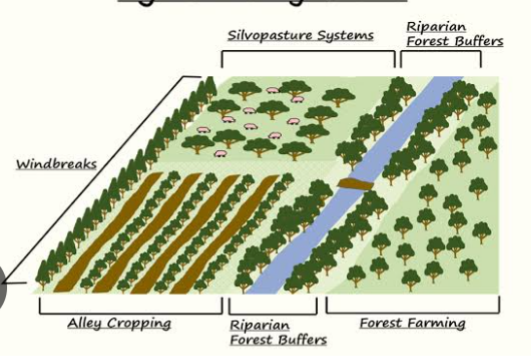
Agroforestry comprises all forms of land use in which woody species (tree and bushes) are grown in combination with vegetation or animals.
(ICRAF) an agroforestry centre define agroforestry as a dynamic ecologically based natural resources management system that through the integration of trees on farms and in the agricultural land scape diversified and sustains production for increase social, economic and environmental benefits for land users at all levels.
The delibrate integration of trees into the farming system differentiate agroforestry from other types of agricultural systems. It involves planting of trees (woody perennials) and at thesame time, planting of arable crops. It is an important practice that help farmers increase their productivity, profitability and sustainable production
Agroforestry is an example of multiple land use (MLU). Multiple land use means the conscious and delebrate use of land for the simultaneous production of two or more goods and services for agricultural production. It involves the combination of goods. Such services may include timber production, grazing, recreation, wildlife, farming, water conservation and soil protection etc.
GOALS OF AGROFORESTRY
1. Prevent the loss of nutrients
2. Provide protection from wind and water erosion
3. Provide organic mulch materials
4. Provide valuable products
5. Make the environment more suitable for livestock
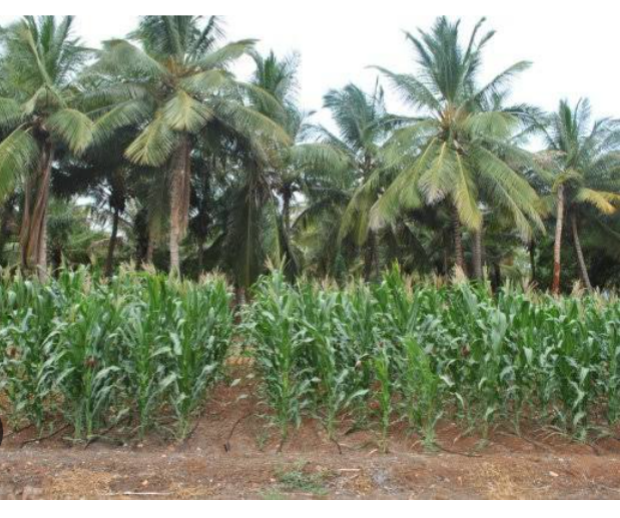
CHARACTERISTICS OF AGROFORESTRY LAND USE PRACTICE
1. PRODUCTIVITY: Agroforestry system should aim at maintaining and increasing production of preferred commodities ( output of the tree products, improve yield of associated crops, reduction of inputs, and increased labour efficiency)
2. SUSTAINABILITY : It conserve the soil for beneficial production of woody perennials on soil. That is, conserving the production potential of the soil resources based mainly through beneficial effect of woody perennials on soil.
3. ADAPTABILITY : Agroforestry system should be able to conform to local farming systems.
CLASSIFICATION OF AGROFORESTRY SYSTEMS AND PRACTICES
There are certain types of practices emback upon to form a dominant land use system in a particular locality and which determine it’s overall biological composition and management. In any agroforestry system, there can be more than one agroforestry practices.
An agroforestry practices refer to a special land management unit such as field management and a specific arrangement temporarily and/or spacially of components.
CRITERIA USED TO CLASSIFY AGROFORESTRY SYSTEM
1. STRUCTURES: Based on the composition of the system, three major agroforestry components include animals, agricultural crops and woody perennials.
2. Functions of the components especially the woody perennials
3. Ecological spread of the components
4. Socioeconomic value of the system
Based on the composition of the structures, agroforestry system are of the following types:
a. Agrosilvicultural system
b. Silvopastoral system
c. Agro Silvopastoral system
Under these types of agroforestry are different practices.
a. AGROSILVICULTURAL SYSTEM : This is an agroforestry system that combines woody perennials with agricultural crops. It has various subsystem called forms.

b. SILVOPASTORAL SYSTEM: This is an agroforestry system that combines woody perennials with animal rearing
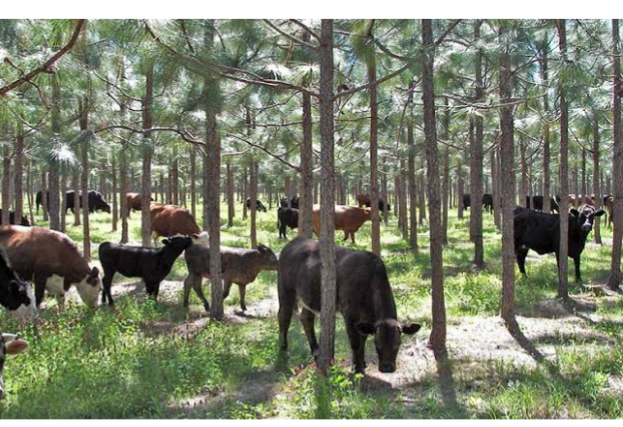
c. AGRO SILVOPASTORAL SYSTEM: This is an agroforestry system that combines the three components
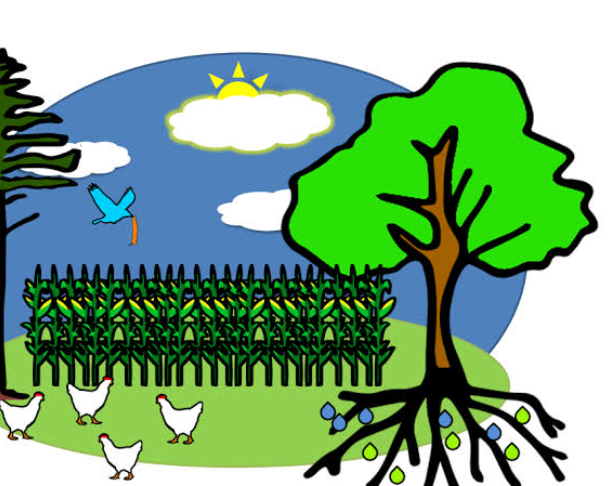
VARIOUS PRACTICES UNDER THE AGROFORESTRY SYSTEMS
a. AGROSILVICULTURAL SYSTEM: Biomas transfer; improved fallow; plantation; trees for fuel wood production; hedge row intercropping or alley cropping and shelter belt, wind break and conservation hedge.
b. SILVOPASTORAL SYSTEM: Live fences for fodder crops; improved production of animals and wood production ; trees and shrubs on pasture
c. AGRO SILVOPASTORAL SYSTEM: Wood hedge-rows for brows, green manure and soil conservation; integrated production of crops, animals and wood; tree-livestock – crop mixed or homested
ADVANTAGES OF AGROFORESTRY
1. Cultivating woody species together with other crop residues reduce nutrient loss. Trees and bushes generally have highly developed roots systems, which can absorb many nutrients that are lost to crops with shallow root systems. The nutrients are stored in the woody species. In this way, they are protected from being leached in periods when no other crops are cultivated. After the leaves or cuttings fall to the ground, the nutrients once again becomes available to the crops through decomposition. This effects of woody species is sometimes called a ‘ nutrient pump’.
2. Trees and shrubs can form hedges that protect crops and soil from wind and the water of heavy rains running off over the surface of the soil.
3. Leaves and cuttings can serve as mulch
4. If trees are planted, it becomes easier to obtain certain products. Fruit trees provide a valuable addition to the diet, the leaves or fruits from trees are fed to livestock, the wood can be used for firewood. Some woody species contain substances that can serve as medicine. If the trees are older, they can also be used as lumber.
5. Livestock can also profit from trees planted in pasture. The trees provide shade and a lower temperature, so the animals perspire less and require less water to drink
DISADVANTAGES AND LIMITATIONS OF AGROFORESTRY
Woody species have larger root systems. This can lead to competition for water and nutrients between the crop and the trees or shrubs
METHODS AND RECOMMENDATIONS
There are many possible ways to combine woody species with crops or livestock. To prevent competition between the woody species and the main crops, it is extremely important to regularly prune the trees or bushes and to thin out their roots by trimming them to one half metres around. The use of trees for firewood, for example, can be more important than their provision for mulch.
SPACIAL ARRANGEMENT OF COMPONENTS IN AGROFORESTRY SYSTEMS
i. TREES ALONG BOUNDARIES : Woody perennials can be planted along boundaries of crop farms
ii. ALTERNATE ROWS: This is the simultaneous planting of trees on a row and agricultural crops on another row
iii. ALTERNATE STRIPS OR ALLEY CROPPING: This is the simultaneous planting of two rows of woody perennials with two or three rows of agricultural crops
iv. RANDOM MIXTURE: This is the planting of agricultural crops in a scattered manner in between the woody trees
v. TEMPORAL ARRANGEMENT: This is arrangement in time. There are different times.
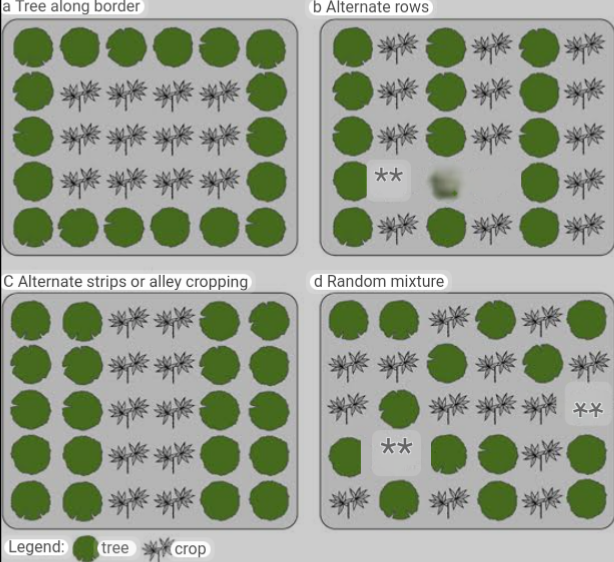
They include:
a. COINCIDENT: This is the growing of agricultural crops like cash crops, pasture, etc under trees. For example, coffee growing under shade trees, grazing grasses with trees within the area.
b. CONCOMITANT: This is the arrangement in which woody perennials and agricultural crops both occupy the piece of land at thesame time but the agricultural crops will be harvested earlier before the harvesting of the woody perenials
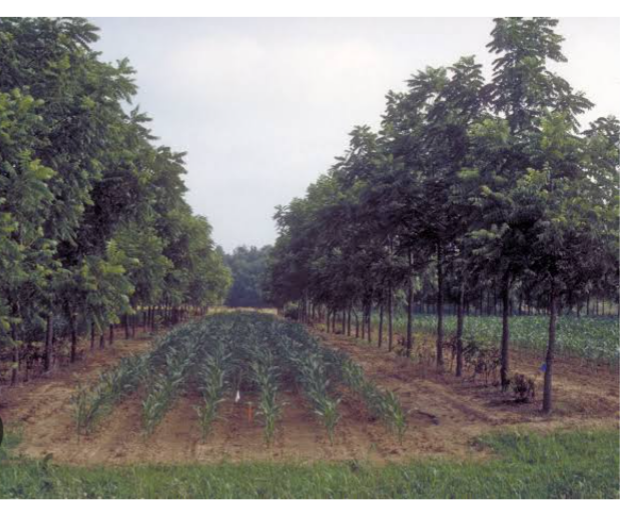
c. INTERMITENT: This is the time arrangement in which woody perennials are growing along with agricultural crops, both having different gestation period. For example, annual crops under coconut tree.
d. INTERPOLATED: This is the time arrangement within home garden whereby livestock, agricultural crops and woody perennials are combined in the farming practice.
e. OVERLAPPING TEMPORAL ARRANGEMENTS: This is the time arrangement in which two components are combined. The two components are woody in nature.
f. SEPARATE TEMPORAL ARRANGEMENT : This is the time arrangement in which woody perenials are planted first and later removed, then agricultural crops are planted. After harvesting of the agricultural crop, the woody perenials are planted again. For example, improved fallow species in shifting cultivation
FUNCTIONS OF AGROFORESTRY SYSTEMS
1. Provision of food security
2. It enhances soil fertility
3. Provision of live fences for crops.
4. Protection of biodiversity
5. Reclamation of degraded soil
6. Carbon sequestration
7. Soil conservation. 8. Weed control
9. Soil water stabilization
10. Improves microclimate
AGROFORESTRY SYSTEMS IN DRY AREAS (ARID AND SEMI ARID)
1. THE USE OF ACACIA ALBIDA IN FIELDS AND PASTURELANDS
Acacia Albida is commonly used in semi arid areas of West Africa. Acacia is a large tree, whose leaves provide shade for cattles in the dry season, and fall at the beginning of the rainy season. This pattern prevent competition with the main crop for light, water and nutrients. Acacia increases soil fertility by providing ‘organic matter in its leaves, nitrogen fixation, a nutrient pump in its extensive root system, and shade for cattle in the dry season, dung of cattle enhances soil fertility’ .
Acacia provides feed for cattle in the form of fruits, leaves and young shoots.
2. WIND BREAK : In semi arid and arid areas, strong winds can sweep away large portion of topsoil. This topsoil is the most fertile part of the soil, to a large extent from applied chemical fertilizers, and after sowing the seed. Wind breaks in the form of rows of trees or shrubs can decrease the loss. The rows will lift the wind, so that their is less wind behind them. Some winds still blows through the row, but it’s force is reduced and fewer soil particles can be swept away by it. Since their is less wind, the humidity in the air stays higher and less moisture evaporates from the soil and crops. This is especially important in dry areas that have a shortage of water.
3. LIVING FENCES: Trees and shrubs can be used as living fences. Fast growing trees can be planted at some distance from each other and this serve as fence posts between which barbed wires can be strung. At the same time, they can provide cattle feed, firewood, green manure, or mulch. Legumineous plants are especially suitable. They supply protein to the animals. A hedge of dense shrubs can be used to fence a piece of land or surround a field of agricultural crop. Moreover, if a hedge of thorny shrubs is used, it is impenetrable for animals to gain entry and destroy crops. It is preferable to use a species that can also provide a product such as cattle feed, fruits or firewood.
AGROFORESTRY SYSTEMS IN WET AREAS WHERE RAIN FALLS THROUGH OUT THE YEAR (SUB HUMID AND HUMID AREAS)
1. LIVING FENCES: Living fences can be used in these areas in thesame way as they are used in the arid areas. Moreover, in wet areas dense hedges of shrubs can be used to separate fields. Competition for water, air and nutrients between the main crop and the shrub is not an issue in sub humid and humid areas. The shrubs can also provide mulch, firewood or cattle feed.
2. SHADE TREES ON PLANTATIONS: Crops such as coffee, tea, vanilla cardamom and peppers prefer to grow in some shade rather than in the full sun. In many areas it is therefore customary to plant shade trees between dense planting of these crops. The amount of shade provided depend on the space between the trees, the form of the leaves, the density of the crown and the height of the trees. In addition to shade, the trees provide products such as lumber, firewood and in some cases cattle feed. Due to the usually abundant volume of fallen leaves, the soil is enhanced with the addition of organic materials, which can remain on the ground to function as mulch. Nitrogen fixers also provide an extra amount of nitrogen.
Shade trees are not suitable for areas that have little rainfall, because competition for water between the crop and the shade trees occurs. A few commonly used trees are Albizzia varieties, Acacia albida, Leucaena glauca, Gliricidia sepium, Erythrina varieties, Sesbania grandiflora, and Cassia etc.
3. GROUND OVERS ON PLANTATIONS:
In plantations of young or sparsely planted rubber, oil palm, coffee, tea, and cocoa, nitrogen fixing ground covers play an important role in erosion control. They protect the soil from the impacts of raindrops and from dehydration, and they add organic materials to the soil when decomposed.
In field of young oil palm and rubber, the creeping species like Centrosema pubescens, Pueraria phaseoloides and Calopogonium mucuniodes are often used. However, their use is objectionable in fields of young coffee, tea, and cocoa trees, which stand much closer together, because the shoots of the creeping nitrogen fixers can climb on the trunks of the young trees. Therefore, it is more suitable to obtain a mulch layer from hedges comprised of Crotalaria and Tephrosia types and Leucaena glauca with Flemingia congesta. The hedges are trimmed just before the dry season, so that their cuttings can serve as mulch. By trimming the hedges just before the dry season, competition for water during that time is minimised. If the hedges are trimmed too short ( to less than 20cm), they take a long time to recover, which reduces the production of mulch.
4. BANANAS IN FREE NURSERIES
Many plantation and fruit trees are not sown directly in the field, but are sown firstly in a central location, where it is easier to maintain them. The trees are sown in bags of fertile soil, often between sparsely planted banana trees or plain trees. These trees can shade the young sprouts, and they provide income in a period when the new trees are not yet productive. By placing the bags close together, they also protect the ground from the impact of raindrops and from dehydration.
ALLEY CROPPING OR HEDGEROW SYSTEM
1. In alley or hedge row cropping, annual crops are sown in lanes that are formed by rows of perennials. The goal of this system is to preserve the soil fertility if the fallow periods ( as in shifting cultivation) becomes increasingly shorter or are discontinued all together.
2. The perennials are planted in parallel rows with a distance of 2 to 4m between the rows and 0.5m between the plants. At the beginning of the raining season, the trees are pruned to a height of 0.5 to1m. The twigs and leaves are laid in the lanes as mulch, the branches are used as firewood or stakes. The crops are sown in the lanes through the mulch layers. During the growing seasons the trees have to be pruned regularly to prevent them from shading the crop. For trees that quickly produce shoots, a height of 0.5m is best, trees that grow slower can be pruned higher. The leaves can be applied to the crops as top dressing or they can be fed to cattle. After the crops have being harvested, the tree shoots can be allowed to grow, so that the trees can provide enough shade to inhibit weed growth.
3. When yams are cultivated as crops they can climb on the stalks of the perennials, which saves the effort of tying them up.
The perennials in the hedge must fulfil the following requirements. They must:
1. Be easy to establish
2. Be fast growing
3. Produce biomass
4. Withstand frequent prunning
5. Be nitrogen fixing crops
6. Have deep root system ( starting with seeds rather than cuttings is preferable, because the directly sown plants develop deeper root system and are more resistant to termites).
ADVANTAGES OF ALLEY CROPPING
1. The most important advantages of this system are that the crop is supplied with nitrogen, and the level of organic matter in the soil is increased.
2. Another Advantage is the suppresion of weeds by shade in the dry season, and by twigs and leaves in the growing season. Water erosion is also prevented.
DISADVANTAGES OF ALLEY CROPPING
1. This system is very labour intensive. If the trees are neglected ( not prunes on time), then crop production will often be lower.
2. In steeply sloping areas, the hedges must follow the contour lines of the land. Twigs, weeds and other materials that wash downhill get stuck on the bottom of tree trunks, creating an accumulation of organic materials that eventually forms terraces. In this way, erosion is prevented.
PLANT SPECIES USED IN AGRGOFORESTY
–Tithonia diversifolia
-Treculia africana
-Gliricidia sepium
-Leucaena leucocephala
-Milletia excelsa
-Kayak spp
-Carica papaya
-Faidherbia albida
